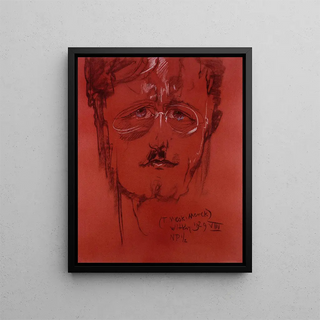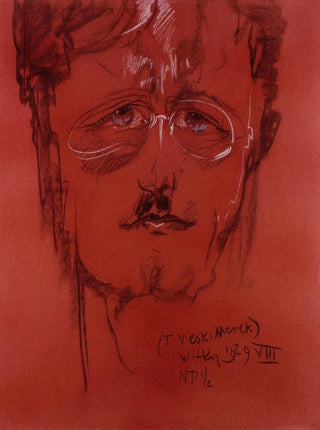Art print | Portrait of Stefan Glass - Stanisław Ignacy Witkiewicz


View from behind

Frame (optional)
Portrait of Stefan Glass - Stanisław Ignacy Witkiewicz – Captivating Introduction
In the vibrant world of art, some works stand out for their ability to capture not only the appearance of a subject but also the very essence of their being. The "Portrait of Stefan Glass" by Stanisław Ignacy Witkiewicz is a striking example. This piece, imbued with profound sensitivity, invites us to delve into the intimacy of a man whose gaze seems to carry the weight of his thoughts and emotions. Through this art print, the viewer is transported into Witkiewicz's universe, a realm where human psychology is illuminated with rare intensity. The encounter between the viewer and the portrait becomes an immersive experience, a silent dialogue between the artist, the model, and ourselves.
Style and uniqueness of the work
Witkiewicz's style is characterized by a bold and innovative approach, blending realistic and abstract elements. In the "Portrait of Stefan Glass," facial features are rendered with striking precision, while the surrounding colors and shapes seem to fade, highlighting the personality of the subject. The background, often blurry and indistinct, creates an atmosphere of introspection, emphasizing the contemplative nature of the piece. The use of light also plays a crucial role; it sculpts the volumes and reveals subtle nuances in Stefan Glass's complexion. This portrait does not merely depict a man; it evokes a psychological depth that transcends the simple visual, prompting the viewer to reflect on human nature and its complexities.
The artist and his influence
Stanisław Ignacy Witkiewicz, an emblematic figure of Polish art in the early 20th century, managed to leave his mark with his unique and avant-garde vision. Writer, playwright, and painter, he explored the intricacies of the human psyche through his works. His innovative approach, inspired by surrealism and expressionism, paved the way for new forms of artistic expression. Witkiewicz was not afraid to incorporate his philosophical and psychological reflections into his art, seeking to depict not only external appearance but

Matte finish

View from behind

Frame (optional)
Portrait of Stefan Glass - Stanisław Ignacy Witkiewicz – Captivating Introduction
In the vibrant world of art, some works stand out for their ability to capture not only the appearance of a subject but also the very essence of their being. The "Portrait of Stefan Glass" by Stanisław Ignacy Witkiewicz is a striking example. This piece, imbued with profound sensitivity, invites us to delve into the intimacy of a man whose gaze seems to carry the weight of his thoughts and emotions. Through this art print, the viewer is transported into Witkiewicz's universe, a realm where human psychology is illuminated with rare intensity. The encounter between the viewer and the portrait becomes an immersive experience, a silent dialogue between the artist, the model, and ourselves.
Style and uniqueness of the work
Witkiewicz's style is characterized by a bold and innovative approach, blending realistic and abstract elements. In the "Portrait of Stefan Glass," facial features are rendered with striking precision, while the surrounding colors and shapes seem to fade, highlighting the personality of the subject. The background, often blurry and indistinct, creates an atmosphere of introspection, emphasizing the contemplative nature of the piece. The use of light also plays a crucial role; it sculpts the volumes and reveals subtle nuances in Stefan Glass's complexion. This portrait does not merely depict a man; it evokes a psychological depth that transcends the simple visual, prompting the viewer to reflect on human nature and its complexities.
The artist and his influence
Stanisław Ignacy Witkiewicz, an emblematic figure of Polish art in the early 20th century, managed to leave his mark with his unique and avant-garde vision. Writer, playwright, and painter, he explored the intricacies of the human psyche through his works. His innovative approach, inspired by surrealism and expressionism, paved the way for new forms of artistic expression. Witkiewicz was not afraid to incorporate his philosophical and psychological reflections into his art, seeking to depict not only external appearance but






